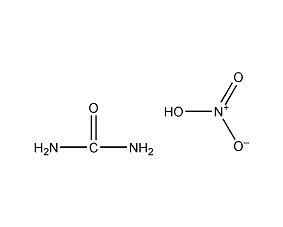
Structural formula
| Business number | 03J9 |
|---|---|
| Molecular formula | CH5N3O4 |
| Molecular weight | 123.07 |
| label |
solid nitric acid, Urea mononitrate, powdered nitric acid, aliphatic compounds |
Numbering system
CAS number:124-47-0
MDL number:MFCD00054386
EINECS number:None
RTECS number:None
BRN number:None
PubChem ID:None
Physical property data
1. Character: colorless or white crystal [1]
2. Melting point (℃): 152 (decomposition) [2]
3. Relative density (water = 1): 1.69[3]
4. Octanol/water partition coefficient: -3.51[ 4]
5. Solubility: Slightly soluble in water, soluble in ethanol, insoluble in nitric acid, ether, benzene and chloroform. [5]
Toxicological data
1. Acute toxicity No data available
2. Irritation No data available
Ecological data
1. Ecotoxicity No data available
2. Biodegradability No data available
3 .Non-biodegradability No information available
4. Other harmful effects[6] This substance is harmful to the environment and should be treated with special Pay attention to water pollution.
Molecular structure data
None
Compute chemical data
1. Reference value for hydrophobic parameter calculation (XlogP): None
2. Number of hydrogen bond donors: 3
3. Number of hydrogen bond acceptors: 4
4. Number of rotatable chemical bonds: 0
5. Number of tautomers: 2
6. Topological molecule polar surface area 135
7. Number of heavy atoms: 8
8. Surface charge: 0
9. Complexity: 53.8
10. Number of isotope atoms: 0
11. Determine the number of atomic stereocenters: 0
12. Uncertain number of atomic stereocenters: 0
13. Determine the number of chemical bond stereocenters: 0
14. Number of uncertain chemical bond stereocenters: 0
15. Number of covalent bond units: 2
Properties and stability
1. There is a risk of combustion and explosion in case of high heat or strong impact. Mixed with organic matter, reducing agents, sulfur, phosphorus, etc., it can form explosive mixtures.
2. Stability[7] Stable
3. Incompatible substances[8] Strong reducing agents, flammable or combustible substances, sulfur, phosphorus
4. Conditions to avoid contact [9] Heat, friction, vibration and impact
5. Polymerization hazard[10] No polymerization
6. Decomposition products[11] Nitrogen oxides
Storage method
Storage Precautions[12] Store in a cool, dry and ventilated warehouse dedicated to explosives. The storage temperature does not exceed 32℃ and the relative humidity does not exceed��80%. If it contains water as a stabilizer, the storage temperature should not be lower than 1℃ and the relative humidity should be less than 80%. Keep away from fire and heat sources. The packaging is sealed. They should be stored separately from oxidants, flammable materials, etc., and avoid mixed storage. Use explosion-proof lighting and ventilation facilities. It is prohibited to use mechanical equipment and tools that are prone to sparks. Suitable materials should be available in the storage area to contain spills. Vibration, impact and friction are prohibited.
Synthesis method
None
Purpose
Used in the manufacture of explosives and organic synthesis intermediates. [13]

 微信扫一扫打赏
微信扫一扫打赏

